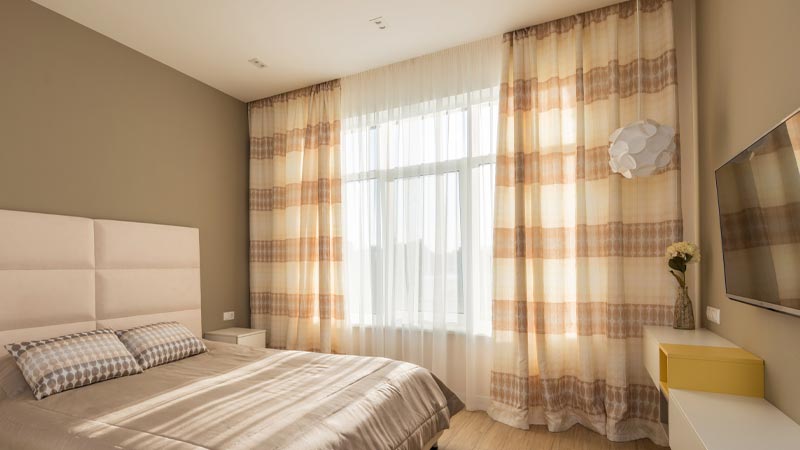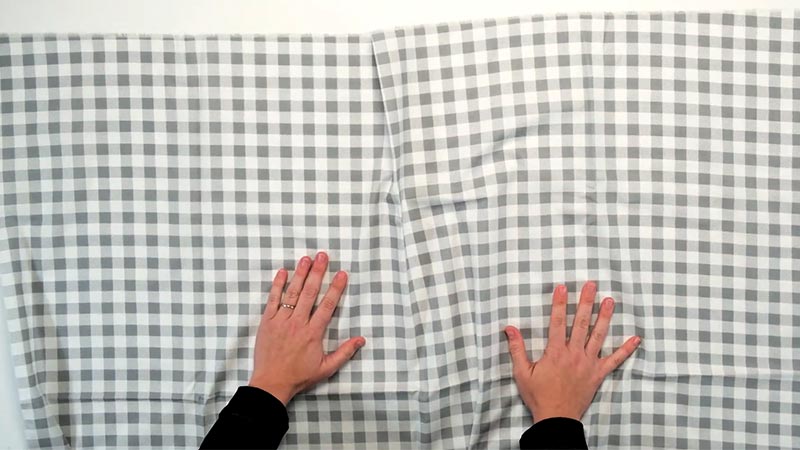Selecting the right fabric for your curtains is a crucial step in creating window treatments that enhance your decor and function effectively.
The process of determining how much fabric you need is not just about dimensions; it involves considerations like fullness, pattern repeats, and personal preferences.
Whether you’re a seasoned seamstress or a novice DIY enthusiast, understanding the intricacies of fabric calculation ensures a well-tailored and visually pleasing result.
In this guide, we will explore the factors that influence your fabric choice and share valuable insights to help you make informed decisions when determining how much fabric you need for your curtains.

How Much Fabric for Curtains Do I Need?
When it comes to making curtains, determining the amount of fabric you’ll need is a crucial step in the process. This ensures you have enough material to create the desired look and fit for your windows.
Here’s a guide on how to calculate the necessary fabric for your curtains:
Measure Your Window
It’s crucial to measure your window accurately. Use a metal tape measure for precision. When measuring the width, start from one outer edge of the window frame to the other.
When you have multiple windows close together, measure each one individually and then add the widths together. For the height, begin from where you plan to hang the curtain rod down to where you want the curtains to end.
Consider Fabric Width
The width of the fabric is a pivotal consideration. Fabrics come in various widths, ranging from 45 inches to 110 inches. Wider fabrics are typically used for larger windows or for a seamless look.
Narrower fabrics may necessitate more seams, especially for wider windows. Choosing a fabric width that aligns with your design vision is essential.
Determine Fullness
Fullness adds a touch of luxury and elegance to your curtains. A standard fullness factor is 2 to 2.5 times the window’s width. This means that you’ll gather or pleat the fabric to create a fuller appearance.
However, consider a fuller curtain with a ratio of 3 or more times the window width for a more opulent and lush look. This can create a rich and dramatic effect.
Calculate Fabric Required
Building on our example with a window width of 60 inches, if you decide on a standard fullness of 2.5 times, you’ll need 150 inches of fabric width.
This extra width ensures the curtains have enough fabric to form elegant pleats or gather when hung.
Calculate Fabric Length
Adding extra inches for hems, headers, and any desired pooling or floor-length effect is crucial. For example, if you aim for floor-length curtains with a 2-inch header and a 4-inch hem, you must add 6 inches to the desired length.
This ensures that when the curtains are hung, they have the desired length and appearance.
Factor in Pattern Repeat
When the fabric you’ve chosen features a repeating pattern, it’s vital to consider this. Carefully measure and consider how the pattern will align when the curtains are sewn.
This may require additional fabric to ensure the pattern appears seamless and well-matched.
Consider Fabric Repeat
Certain fabrics have a vertical repeat, meaning the pattern is duplicated regularly.
This consideration is especially important for large or intricate patterns, affecting how you cut and align the fabric. Ensuring that the pattern repeat is consistent creates a polished and professional finish.
Purchase Extra Fabric
Though not mandatory, buying a bit more fabric than your calculations suggest can be a prudent choice.
This extra material can be a lifesaver in case of mistakes or unforeseen complications during the sewing process. It provides a safety net and ensures you have enough material to complete the project satisfactorily.
Calculate Yardage
After determining the total inches of fabric width and length, divide by 36 to get the total yards needed.
Always round up to ensure you have sufficient material. This step ensures you purchase the correct amount of fabric, minimizing the risk of running out during the sewing process.
Final Check
Before making your purchase, revisit your calculations and consider any additional factors, such as the need for lining material or tiebacks, which will also require fabric.
This final check ensures you have accounted for all necessary materials for your curtain project.
Tips for Fabric Selection

Selecting the right fabric is crucial for any sewing or crafting project.
Here are some tips to consider when choosing fabric:
Purpose and Use
When selecting fabric, it’s crucial first to consider its intended purpose. Are you planning to make clothing, curtains, or perhaps upholstery? Each of these applications requires a different type of fabric.
For instance, upholstery fabric needs to be durable and able to withstand regular wear and tear, while clothing fabric should be comfortable against the skin.
Fiber Content
The type of fibers used in a fabric can greatly impact its characteristics. Natural fibers like cotton, linen, silk, and wool offer breathability and a comfortable feel.
On the other hand, synthetic fibers such as polyester, nylon, and rayon often provide durability and wrinkle resistance. Blends combine the benefits of both natural and synthetic fibers.
Durability
Consider how durable the fabric needs to be based on its intended use. Opt for sturdier fabrics like canvas for projects that will be subjected to heavy use, like upholstery or tote bags.
Softer and more delicate fabrics like chiffon or satin may be appropriate for delicate items or clothing.
Color and Pattern
The color and pattern of the fabric are pivotal aspects of any project. Think about the overall design scheme or the aesthetic you want to achieve.
Consider the existing color palette of a room for home decor projects, or choose patterns that complement the style of clothing you’re making.
Texture and Feel
The texture of a fabric can greatly influence the look and feel of the final product. For example, if you’re crafting a cozy blanket, you’d want a soft and plush fabric.
Conversely, a stiffer material might be more suitable if you’re working on a structured garment.
Weight and Thickness
Take into account the weight and thickness of the fabric. Lighter fabrics like chiffon are perfect for draping and creating a flowing effect, while heavier materials like denim or canvas are better suited for structured garments or durable home goods.
Stretch and Drape
Consider whether the fabric needs to stretch, which is important for projects like activewear or form-fitting garments.
Additionally, pay attention to how the fabric drapes. Fabrics with good drapes are ideal for projects like curtains or dresses, where the way the fabric falls is crucial.
Care Instructions
It’s essential to check the care label on the fabric. Different fabrics may require specific care, such as dry cleaning or hand washing.
Understanding how to care for the fabric properly ensures that your project will last and maintain its quality over time.
Budget
Setting a budget for your fabric is important. Specialty or high-quality fabrics can be more expensive, so it’s good to know how much you’re willing to invest in your project.
Test Swatches
Obtaining a small sample or swatch of the fabric is advisable whenever possible. This allows you to test how the fabric behaves when sewn, washed, and used. It’s a valuable step to ensure the fabric works well for your project.
Consider the Environment
For environmentally conscious consumers, considering the eco-friendliness of the fabric is important.
Look for fabrics made from sustainable materials or those with eco-friendly production processes. Consider factors like dyeing methods and biodegradability.
Check for Allergies
When allergies are a concern, it’s important to be mindful of potential sensitivities to certain fabrics. Some individuals may have allergies or sensitivities to specific types of fibers, so selecting hypoallergenic options may be necessary.
FAQs
How do I measure my window for curtain fabric?
Measure the width from one outer edge of the window frame to the other and the height from where you plan to hang the curtain rod to where you want the curtains to end.
What is fabric width, and how does it affect my calculations?
Fabric width refers to the width of the fabric roll. It affects how many panels or seams you’ll need.
What is the standard fullness for curtains?
The standard fullness for curtains is typically 2 to 2.5 times the width of your window. This extra fabric allows for pleats or gathers, creating a fuller look.
Should I factor in pattern repeat when calculating fabric needs?
If your chosen fabric has a repeating pattern, consider how it will align. You may need extra fabric to match the pattern seamlessly.
Is it advisable to buy extra fabric when calculating yardage for curtains?
It’s a good idea to purchase a bit more fabric (around 10-15%) to account for mistakes, pattern matching, or unforeseen issues during sewing.
Wrap Up
Mastering the art of calculating the right amount of fabric for your curtains is a skill that transforms a project from good to outstanding. It involves precision, an eye for design, and an understanding of fabric characteristics.
By considering factors like fullness, pattern repeat, and texture, you ensure curtains that fit your windows perfectly and harmonize with your interior. Remember, a little extra fabric can be a lifesaver, offering flexibility for adjustments.
Armed with this knowledge, you’re ready to embark on your curtain-making journey, confident in your ability to create window treatments that are as functional as they are aesthetically pleasing.
Leave a Reply